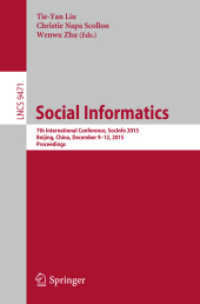- ホーム
- > 洋書
- > 英文書
- > Psychology
基本説明
Covers theoretical issues and empirical results from both behavior and neurophysiology.
Full Description
This book provides an introduction into both computational models and experimental paradigms that are concerned with sensory cue integration both within and between sensory modalities. Importantly, across behavioral, electrophysiological and theoretical approaches, Bayesian statistics is emerging as a common language in which cue-combination problems can be expressed. This book focuses on the emerging probabilistic way of thinking about these problems. These approaches derive from the realization that all our sensors are noisy and moreover are often affected by ambiguity. For example, mechanoreceptor outputs are variable and they cannot distinguish if a perceived force is caused by the weight of an object or by force we are producing ourselves. The computational approaches described in this book aim at formalizing the uncertainty of cues. They describe cue combination as the nervous system's attempt to minimize uncertainty in its estimates and to choose successful actions. Some computational approaches described in the chapters of this book are concerned with the application of such statistical ideas to real-world cue-combination problems, such as shape and depth perception. Other parts of the book ask how uncertainty may be represented in the nervous system and used for cue combination.
The broadening scope of probabilistic approaches to cue combination is highlighted in the breadth of topics covered in this book: the chapters summarize and discuss computational approaches and behavioral evidence aimed at understanding the combination of visual, auditory, proprioceptive, and haptic cues. Some chapters address the combination of cues within a single sensory modality while others address the combination across sensory modalities. Neural implementation, behavior, and theory are considered. The unifying aspect of this book is the focus on the uncertainty intrinsic to sensory cues and the underlying question of how the nervous system deals with this uncertainty.
The book is intended as a reference text for graduate students and professionals in perceptual psychology, computational neuroscience, cognitive neuroscience and sensory neurophysiology.
Contents
Preface ; I. Theory and Fundamentals ; 1. Ideal-Observer Models of Cue Integration ; Landy, Banks, & Knill ; 2. Causal Inference in Sensorimotor Learning and Control ; Wei & Kording ; 3. The Role of Generative Knowledge in Object Perception ; Battaglia, Kersten, & Schrater ; 4. Generative Probabilistic Modeling: Understanding Causal Sensorimotor Integration ; Vijayakumar, Hospedales, & Haith ; 5. Modeling Cue Integration in Clutter ; Sahani & Whiteley ; 6. Recruitment of New Visual Cues for Perceptual Appearance ; Backus ; 7. Combining image signals before 3D reconstruction: The Intrinsic Constraint Model of Cue Integration ; Domini & Caudek ; 8. Cue Combination: Beyond So-Called "Optimality" ; Rosas & Wichmann ; II. Behavioral Studies ; 9. Priors and Learning in Cue Integration ; Seydell, Knill, & Trommershauser ; 10. Combining Vision With Audition and Touch, In Adults and In Children ; Burr, Binda, & Gori ; 11. The Statistical Relationship







